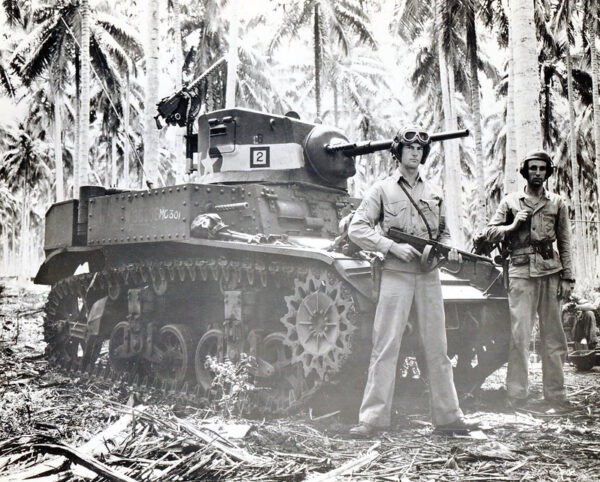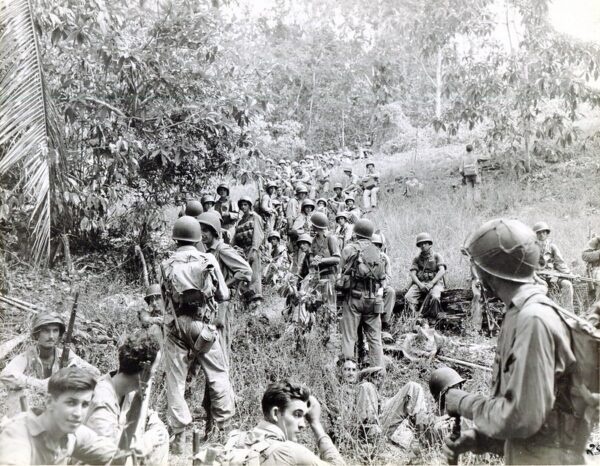
U.S. Marines held Guadalcanal through the entirety of the Solomon Islands campaign during World War II. (Photo: U.S. Marines Archives)
Part of the Solomon Islands Campaign, the Battle of Guadalcanal was a major turning point in the war against Imperial Japan in the Pacific theater of World War II. It ended Japan’s outward expansion and allowed the Allies to gain a foothold in the Pacific, eventually leading to victory over Japan.
Prelude to the Battle of Guadalcanal
After Imperial Japan’s surprise Attack on Pearl Harbor in late 1941, the United States struggled to protect its assets in the Pacific. Japan continued to conquer territories of strategic or economic importance through the first half of 1942, but a string of U.S. and Allied victories in summer and early fall sapped the Axis power’s momentum.
First, the Battle of the Coral Sea — a decided stalemate at the time — significantly hampered Japan’s aircraft carrier fleet. Any chance of Japan evening the score decisively failed after the Allies struck a critical blow against Japan’s fleet at the Battle of Midway. Forced on the defensive, Japan tried to solidify its holdings in the South Pacific with new airbases and entrenched troops.
Allied intelligence discovered that Japan had begun building on such base in the southern Solomon Islands, important because they were within striking distance of crucial Allied supply lines and bases. Seizing the momentum, the United States elected to capture the islands so the proposed airfields could instead be used against the Japanese.
Aug. 7, 1942 – Feb. 9, 1943: The Battle of Guadalcanal rages by air, land, and sea
U.S. Marines landed and captured Japan’s major airfield on Guadalcanal within 36 hours, surprising the Japanese defenders. However, this success would be short-lived, Japan’s counterstrike decimated the Allied naval presence, leading to a back-and-forth naval stalemate for the next two months. Significant casualties occurred on both sides, especially for the Allies whose only major advantage was the ability to quickly replenish ships and supplies.
Meanwhile, the ground battle, though severe, never fell out of favor for the Marines. The toughest fighting occurred in mid-October when a sizable Japanese force was repelled, and the Marines were able to start pushing toward the northern end of the islands.
By late January, Japanese forces were forced to flee the southern Solomon Islands.

(Photo: U.S. Marines Archive)
Legacy of the Battle of Guadalcanal
The ground battle at Guadalcanal would prove to be a major success for Allied forces while the naval theater demonstrated the Allied navies’ ability to better adapt, replace, and replenish their forces.
Exact casualty numbers among U.S. troops remain unclear as more died from tropical diseases than enemy fire. However, the number is estimated to be roughly 7,100 dead and another 7,900 wounded.
Japanese casualties were far more severe. Of the 36,200 men deployed to the southern Solomon Islands, it’s estimated that only 12,000 survived, a preview of the harsh defeats Japan would suffer in subsequent campaigns.
Ultimately, victory at Guadalcanal served to boost American morale while beginning a long trend of retaking territory formerly occupied by Imperial Japan.
To learn about more U.S. Military events and veterans holidays, click here.














John Wayne made a movie based on the exploits of American Marines and Sailors. This movie. Guadalcanal lifted the spirits of the homefront Americans.
May The Duke live long in the lore of American fighters
QUESTION NO COMMENT!
I SERVED TWO TOURS ONBOARD THE USS INTREPID CVS 11 DURING THE VIETNAM WAR AND BEEN TRYING FOR SOMETIME TO LEARN IF IT WAS LISTED AS A WAR SHIP THAT QUALIFIES FOR AGENT ORANGE. AS STATED
“1966 COMBAT IN SOUTHEAST ASIA
In 1966, Intrepid was converted to a “special attack carrier” and was deployed to Vietnam, where the ship served three tours of duty between 1966 and 1969. Aviators bombed strategic targets in North and South Vietnam as part of Operation Rolling Thunder.
VIETNAM WAR VICTORIES AND LOSSES
Intrepid aviators attacked a range of targets, including transportation links, petroleum resources and industrial facilities. Intrepid pilots scored two shoot-downs of North Vietnamese aircraft. Three pilots became prisoners of war, and 21 men lost their lives in combat or in operational accidents.